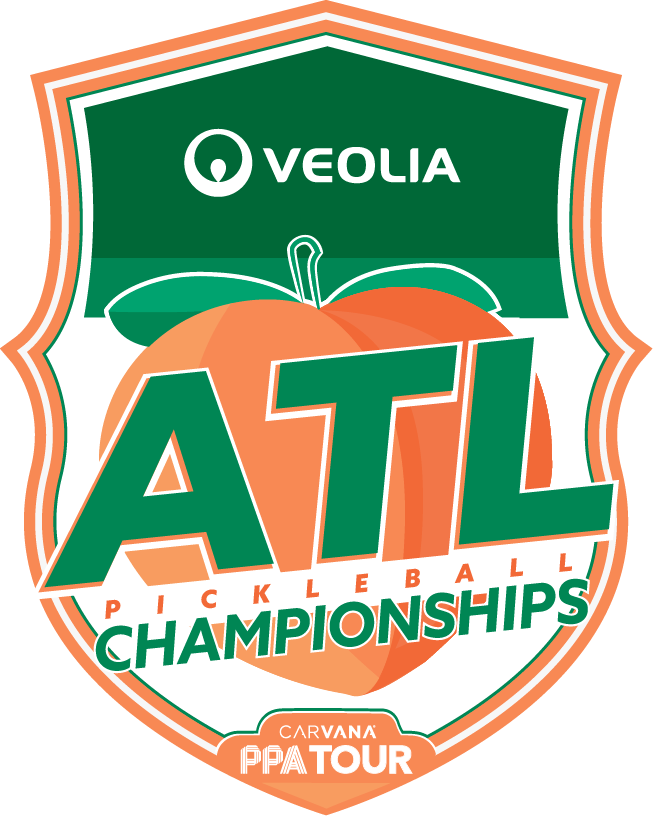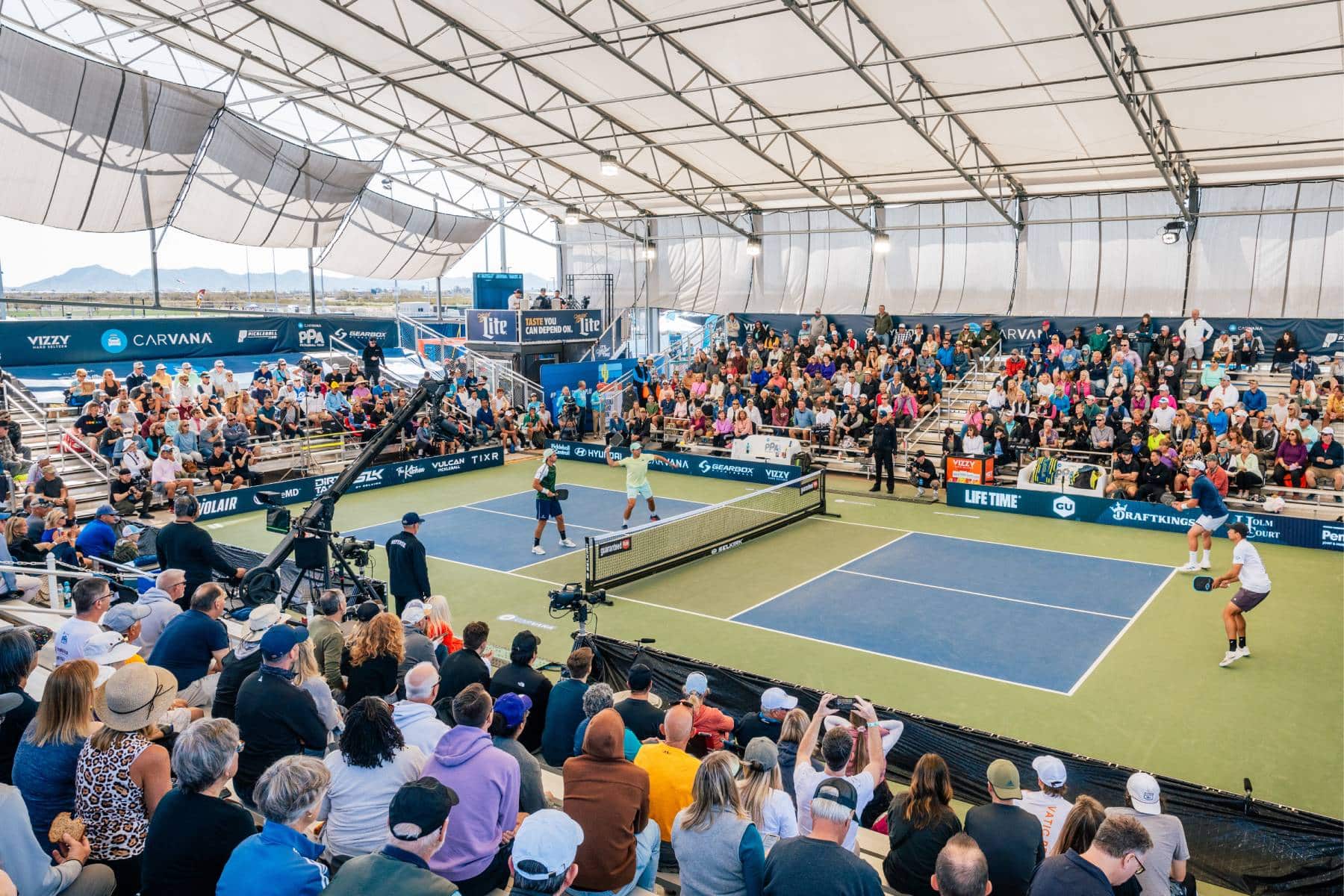Learn More About Pickleball
WHAT IS PICKLEBALL?
Pickleball is a paddle and ball sport which has become the fastest-growing in the United States. It combines elements of tennis, badminton and ping pong and can be played as either singles or doubles.
The paddles are made of wood or other composite materials and the ball is plastic with small holes in it.
Read on for a complete look at the game, including how it began, all about the equipment of the game, rules on serving and scoring, gameplay, and even about how pickleball has progressed and its popularity in recreational and professional levels.
To learn how to play the game, read here.
THE ORIGINS OF PICKLEBALL
The origins of pickleball date to 1965 when it was invented by friends Joel Pritchard, Bill Bell and Barney McCallum in Washington. The idea for the game came when they were looking for a fun, outdoor activity for their families.
The game was played on the same size court as badminton with a net in the middle to divide the sides. However, the net was eventually lowered from badminton height to what we see now in pickleball.
The three were initially trying to get a game of badminton going, but they couldn’t find the equipment necessary. Instead, they improvised and used ping pong paddles and a plastic ball. The court was originally set up on Pritchard’s concrete badminton court.
The name “pickleball” was conceived by Pritchard’s wife, Joan. She said the game reminded her of the “pickle boat” in crew, where the oarsmen were chosen from the leftover people, comparing it to the hybrid game Pritchard and his friends came up with.
The first pickleball tournament was held in Washington in 1972.
PICKLEBALL EQUIPMENT AND SETUP
The pickleball court is 44-feet long by 20-feet wide. On each side of the net, the court is divided into three quadrants – the non-volley zone and the left and right service boxes. The net divides the court in half and is 36-inches high at the posts and 34-inches high in the middle.
Pickleball courts are built with concrete or pavement, then covered with a surface topcoat made of paint, sand, and other materials. The recommended overall dimensions of a court when the out-of-bounds area surrounding the court is included is 60’ x 30’ (length times width in feet).
Pickleball paddles were often made of wood in the beginning, but plastic soon took over, followed by composite materials like carbon fiber, graphite, and fiberglass. A pickleball is hard, lightweight plastic with holes all over. Indoors balls generally have 26 holes while outdoor balls usually have 40 holes.
Learn more about the pickleball equipment needed to play pickleball.
PICKLEBALL SCORING
Pickleball games are to 11 and matches are generally the best two-of-three games. Only the serving team can score points in regular tournament play. If the serving team wins a rally, it scores a point. If the receiving team wins a rally, it does not receive a point. However, after the receiving team wins two rallies, it earns the serve and then gets two of its own chances to score points.
In doubles pickleball, both members of the team get a chance to serve. If the first server’s team wins a rally, the same server continues to serve the next rally, serving from the opposite side of the court from where he or she was previously. If there is a fault by the serving team, the second server gets an opportunity to serve and score a point.
Read our scoring guide to learn more about scoring in pickleball.
PICKLEBALL RULES
The basic rules of pickleball center around the non-volley zone, an area 7-feet from the net on both sides of the court. In this area, a player may not volley, which is a shot where the ball is hit out of the air rather than off the bounce.. A player may step into the area, stay in the area, and hit from the area at any time, so long as the player doesn’t hit the ball as a volley – hence the name, the non-volley zone. The non-volley zone is also often colloquially referred to by players as “the kitchen” and phrases like “stay out of the kitchen” are common to hear on court.
The serve must be made underhand, or after a drop of the ball. The ball cannot be dropped or tossed up in the air if it’s not hit on a volley. A volley serve must be struck from below the waist and in an upward fashion. The serve must clear the non-volley zone and hit the opposite side of the court. The receiving team must wait for the ball to bounce before it is struck.
(learn more pickleball serving rules and how to serve in pickleball)
One of the main things that separates pickleball from tennis is the double-bounce rule. After the serving team hits the ball, the receiving team must let it bounce. However, unlike tennis, in pickleball, the serving team also has to let the ball bounce on its end of the court. After the ball has bounced once on each side of the court it may be volleyed, as long as it’s not in the non-volley zone.
A fault is committed if the serving team does not clear the net, the non-volley zone or if it lands out of play. A fault is also committed if a player steps into the non-volley zone and strikes the ball before it bounces.
Pickleball can be played as singles, women’s doubles, men’s doubles, or mixed doubles, with the doubles divisions being by far the most popular amongst players. The rules of singles vs. doubles are virtually the same, with just a few basic differences between service positioning and scoring.
The above are the basic rules of pickleball. Obviously, there are additional rules and regulations, as well as tournament play, but the fundamentals of understanding the non-volley zone and the double-bounce rule are instrumental in understanding pickleball.
PICKLEBALL STRATEGY
Because the court is so small, gameplay can be fast and exciting, a mix between ground strokes and quick volleys. However, because of the non-volley zone, many of the most-successful shots are the short “dinks” that land close to the net. A large part of the strategy of the game is hitting shots that can’t be attacked, and oftentimes dink shots don’t allow for it. In addition, when players are standing close to the non-volley zone and just 14 feet from their opponents, a fast shot that gets blocked comes back equally as fast and becomes problematic.
At the lower levels of play, more shots are hit higher and faster. The more advanced the players, the more likely there will be more shots in the non-volley zone, effectively slowing the game down to some extent.
PICKLEBALL POPULARITY
One of the great things about pickleball is how easy it is for anyone to learn to play. Since the barrier to entry is so low and the game can be played by people of different ages and fitness levels, it has soared in popularity, especially in the United States.
To play, you only need a paddle and a ball, which makes it even more accessible to people. In addition, pickleball also offers a number of health and social benefits. As far as health goes, pickleball is good exercise, an engaging way to stay active and contribute to a healthy lifestyle. Pickleball is a low-impact sport, so that means even more people can have some success playing the game, unlike tennis, where it is significantly more physically demanding.
Socially, since the court is so small and the players are close to each other, pickleball provides lots of opportunities to create camaraderie and fun.
The increase in pickleball-related restaurants, centers and gyms has also attracted more people to the game, resulting in a huge increase in tournaments across the country. Many communities are also investing in pickleball courts to meet the demand for people who want to play.
Overall, these factors have created a lot more players, a lot more serious players and an increase in new players in the game.
PROFESSIONAL PICKLEBALL
There are a number of professional pickleball entities, including the PPA Tour, which has the game’s top players signed to exclusive competitive contracts. The PPA Tour held its first professional and amateur tournament in February of 2020, and this year, the PPA Tour will have more than two dozen events. It runs the entirety of the year and holds tournaments all over the country. In 2025, the PPA Tour debuted its International Tournament Series, which takes its professional players all over the world to compete.
The PPA Tour also has a sister company, Major League Pickleball, which offers a different format and competitive structure that is built around teams rather than individuals. The two entities are owned by the umbrella company, the United Pickleball Association (UPA). In 2024, the UPA also announced the formation of the new governing body of pickleball, the UPA-A, to consolidate rules, paddle testing, sanctioning, education, international outreach, and more.
PICKLEBALL TOURNAMENTS
There are pickleball tournaments offered all over the U.S. and the world for all ages and all levels of players. Tournament brackets are broken down by both age group and skill in order to pit players against opponents of a similar level.
Packing and preparing well for a pickleball tournament is crucial. Brackets can run for hours, so if a player keeps winning, he/she may be on-site all day long with limited food, beverage, and recovery options.
One of the things that sets pickleball apart from other sports is the double elimination format used during tournament play. A player or team is not bumped out of the competition until they’ve lost twice, and it is possible for a player or team to win a tournament even if they’ve lost a match.
Playing pickleball tournaments allows amateur players to build their rating which is a four digit number designating a player’s skill level. Skill level ranges from 2.000 to 8.000 (novice to expert). Pickleball rankings or standings designate where a player falls in relation to other players, with the best pickleball player in the world in the #1 ranking spot and all other players holding the spots beyond #1 and stretching out infinitely.


